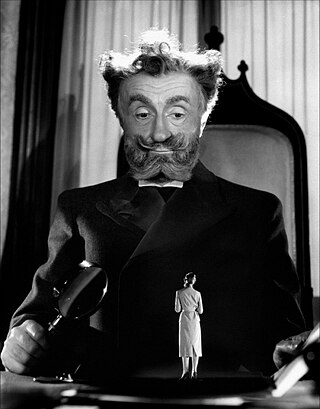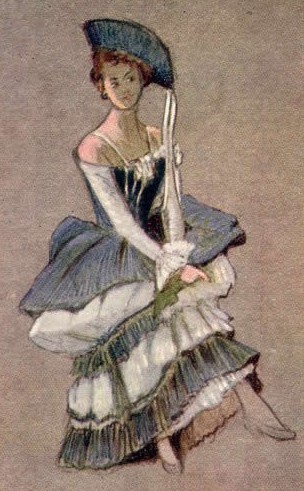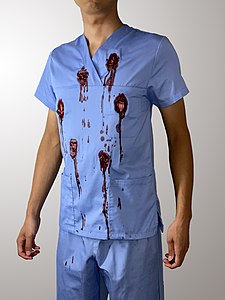Costume is the distinctive style of dress or cosmetic of an individual or group that reflects class, gender, profession, ethnicity, nationality, activity or epoch. In short costume is a cultural visual of the people.
A film crew is a group of people, hired by a production company, for the purpose of producing a film or motion picture. The crew is distinguished from the cast, as the cast are understood to be the actors who appear in front of the camera or provide voices for characters in the film. The crew is also separate from the producers, as the producers are the ones who own a portion of either the film studio or the film's intellectual property rights. A film crew is divided into different departments, each of which specializes in a specific aspect of the production. Film crew positions have evolved over the years, spurred by technological change, but many traditional jobs date from the early 20th century and are common across jurisdictions and filmmaking cultures.

Special effects are illusions or visual tricks used in the theatre, film, television, video game, amusement park and simulator industries to simulate the imagined events in a story or virtual world.

Prosthetic makeup, which may also be referred to as special make-up effects or FX prosthesis, is the process of using prosthetic sculpting, molding, and casting techniques to create advanced cosmetic effects. Prosthetic makeup draws a straight lineage from the Stagecraft of theater and can be observed at the birth of science fiction cinema with Le Voyage dans La Lune, a 1902 French adventure short film directed by pioneer of special effects Georges Méliès.

A stunt performer, often called a stuntman or stuntwoman and occasionally stuntperson or stunt-person, is a trained professional who performs daring acts, often as a career. Stunt performers usually appear in films or on television, as opposed to a daredevil, who performs for a live audience. When they take the place of another actor, they are known as stunt doubles.
In filmmaking, a double is a person who substitutes for another actor such that the person's face is not shown. There are various terms associated with a double based on the specific body part or ability they serve as a double for, such as stunt double, "dance double", "butt double" and "hand double".

A practical effect is a special effect produced physically, without computer-generated imagery or other post-production techniques. In some contexts, "special effect" is used as a synonym of "practical effect", in contrast to "visual effects" which are created in post-production through photographic manipulation or computer generation.

A blank is a firearm cartridge that, when fired, does not shoot a projectile like a bullet or pellet, but generates a muzzle flash and an explosive sound like a normal gunshot would. Firearms may need to be modified to allow a blank to cycle the action, and the shooter experiences less recoil with a blank than with a live round. Blanks are often used in prop guns for shooting simulations that have no need for ballistic results, but still demand light and sound effects, such as in historical reenactments, special effects for theatre, movie and television productions, combat training, for signaling, and cowboy mounted shooting. Specialised blank cartridges are also used for their propellant force in fields as varied as construction, shooting sports, and fishing and general recreation.

A squib is a miniature explosive device used in a wide range of industries, from special effects to military applications. It resembles a tiny stick of dynamite, both in appearance and construction, but has considerably less explosive power. A squib consists of two electrical leads separated by a plug of insulating material; a small bridge wire or electrical resistance heater; and a bead of heat-sensitive chemical composition, in which the bridge wire is embedded. They can be used to generate mechanical force to shatter or propel various materials; and for pyrotechnic effects for film and live theatrics.
Wire fu is an element or style of Hong Kong action cinema used in fight scenes. It is a combination of two terms: "wire work" and "kung fu".

Costume design is the creation of clothing for the overall appearance of a character or performer. Costume may refer to the style of dress particular to a nation, a class, or a period. In many cases, it may contribute to the fullness of the artistic, visual world which is unique to a particular theatrical or cinematic production. The most basic designs are produced to denote status, provide protection or modesty, or provide visual interest to a character. Costumes may be for a theater, cinema, musical performance, cosplay, parties, or other events. Costume design should not be confused with costume coordination which merely involves altering existing clothing, although both create stage clothes.

Stage clothes is a term for any clothes used by performers on stage. The term is sometimes used only for those clothes which are specially made for the stage performance by a costume designer or picked out by a costume coordinator. Theatrical costumes can help actors portray characters' age, gender role, profession, social class, personality, and even information about the historical period/era, geographic location, time of day, as well as the season or weather of the theatrical performance. Stage clothes may be used to portray a historical look or they can be used to exaggerate some aspect of a character.

Theatrical blood, stage blood or fake blood is anything used as a substitute for blood in a theatrical or cinematic performance. For example, in the special effects industry, when a director needs to simulate an actor being shot or cut, a wide variety of chemicals and natural products can be used. The most common is red food coloring, often inside small balloons coupled with explosive devices called squibs.

Bodily mutilation in film refers to practical effects implemented on a film set during production, in contrast to special effects, which are applied in post-production. The primary objective is to visually depict physical trauma endured by a character, aiming to elicit emotional responses from the audience and foster empathy towards the character. Bodily mutilation is most usually portrayed in the context of horror, but is also used in other genres, such as medical dramas or war films. It is used primarily either to shock or fascinate the audience of a film, or to add a sense of realism. Improved special effects in recent decades have seen an increase in the prevalence of bodily mutilation in film.

Costume coordination is a method of dressing actors, employees or a person or group for theatrical productions and any venue requiring a fully realized character. It consists of pulling or renting existing stock clothing and costumes, altering them as needed to be used as stage clothes in a theatrical production, oversee their use, cleaning and eventual return to storage or rental company. Just as with costume design, the costume coordinator creates the overall appearance of the characters, but with the use of on hand items, including accessories. Sometimes coordinators may have a small budget to augment the existing stock or alter it for production needs.
The following outline is provided as an overview of and topical guide to stagecraft:
Cathy Cooper is a postmodern artist and wardrobe stylist who lives and maintains a studio in Los Angeles. Working as a costume and wardrobe designer for the past 28 years, she has been collaborating with directors, musicians, commercial advertisers and photographers. Cooper completed the costuming and wardrobe for the Los Angeles Philharmonic's productions of Igor Stravinsky's Firebird ballet choreographed version of Ravel's Boléro.

Creature suits are realistic costumes used to disguise a performer as an animal, monster, or other being. They are used in film, television, or as costumed characters in live events. Unlike mascots, they are often made with a high degree of realism. In contrast with prosthetic makeup, which is applied to an actor's skin, the wearer is not normally visible outside their movements controlling the costume, although in some cases, part of the wearer's body is still visible.

A bullet hit squib or a blood squib is a practical, pyrotechnic special effect device used mainly in the film industry, TV shows and stage performances and even in first responder moulage training to simulate the appearance of a person being shot and wounded. This is achieved by blowing open a pre-scored hole on the actor's clothing and bursting a fake blood packet with a small explosion, creating an aesthetic that filmmakers and audiences alike have become accustomed to associating with a gunshot wound.
The special effects of the 1991 American science fiction action film Terminator 2: Judgment Day were developed by four core groups: Industrial Light & Magic (ILM), Stan Winston Studio, Fantasy II Film Effects, and 4-Ward Productions. Pacific Data Images and Video Images provided some additional effects.



























